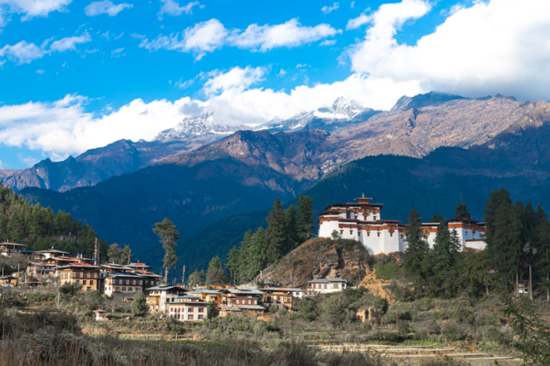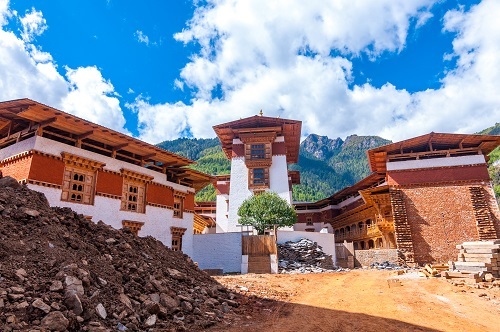
Drukgyal Dzong means ‘Fortress of the Victorious Drukpa’. Located in Phondey village, Paro district, Drukgyel Dzong was believed to have been built in 1646 by Zhabdrung Ngawang Namgyal to commemorate his victory over the Tibetan invaders. Others account that it was Tenzin Drugda, the second Desi, (who was Paro Penlop at the time) who assembled it at the command of Zhabdrung Ngawang Namgyal.
Drukgyal Dzong’s historical significance and strategic location make it a highlight of Bhutan's tours, offering visitors a glimpse into the country's rich heritage and military history.
These tours include the Dzong's panoramic views and ongoing restoration efforts, which provide a unique blend of history and natural beauty. Here are x amazing facts about this fortress, explaining why it’s a must-see for travelers.
1. Drukgyel Dzong Was Built With A Strong Defensive Design

Image Credit: Unsplash
Drukgyal Dzong’s defensive design was highly strategic, ensuring maximum protection. Built on a hill with steep cliffs on three sides, the fortress was only accessible through a single, heavily guarded entrance. Watchtowers between the entrance and the base of the hill were monitored for any advancing threats. The dzong exemplifies traditional Bhutanese architecture with its robust construction and intricate design. It features a false entrance designed to deceive returning Tibetan invaders and lure them into an enclosed courtyard for a second attack.
This layout minimized vulnerability to attacks. Additionally, tunnels once provided safe access to water from the river, a crucial feature during prolonged sieges. Its location and architectural elements made Drukgyal Dzong an effective military stronghold, safeguarding the Paro Valley.

2. The Only Dzong Used For Defense Stronghold Without Other Functions
The ancient fortress served as an important defense base in the region and housed sacred documents until 1951, when it was almost destroyed by fire. Unlike the other ancient fortresses in the country, Drukgyel Dzong is the only dzong used for defensive purposes without any religious or administrative functions. It is one of the four principal Taa Dzong (defense fortresses). The other defense fortresses in Bhutan are Gasa Trashi Thongmon Dzong, Haa Damthang Dzong and Lingzhi Dzong.
3. It Became A Strategic Stop For caravans And Traders
After the Tibetan invasions ended, Drukgyal Dzong became a key stopover for traders. Bhutan exported rice to Tibet, while salt and tea were imported from Tibet in return.
The Dzong’s strategic location made it a crucial point where caravans could rest before continuing their journey through the Tremo La pass, a major trade route connecting the two regions. This exchange of goods not only bolstered Bhutan’s economy but also strengthened its cultural ties with Tibet, with Drukgyal Dzong playing a central role in facilitating this trade.
4. The Restoration Efforts To Preserve Drukgyel Dzong
The existing ruins and original defense structure of the Drukgyel Dzong are well preserved and protected. The ancient ruins of Drukgyel Dzong is a famous archaeological site in Bhutan. This impressive structure was even featured in the National Geographic magazine in 1914. Despite the fire in 1951, the glory of Drukgyel Dzong remains until today. It is listed as a tentative site in Bhutan's Tentative List for UNESCO inclusion.
In April 2016, to celebrate the birth of the Dragon Prince, Gyalsey His Royal Highness Jigme Namgyel Wangchuck, as well as to commemorate the arrival of Zhabdrung Ngawang Namgyel to Bhutan in 1616 AD and the birth year of Guru Rinpoche, then Prime Minister Tshering Tobgay announced that the dzong will be restored and reinstated to its former glory upon the command of His Majesty King Jigme Khesar. The announcement and groundbreaking ceremony took place on 6 February 2016, a day after the Crown Prince was born.
The physical structure of Drukgyal Dzong is about 90% complete, with project managers indicating that the final phases are underway and expected to be completed by the end of 2024. While it is not fully completed, it is accessible to visitors.
Conclusion About Drukgyal Dzong Facts
The Drukgyal Dzong is a remarkable monument that proves Bhutan's historical richness and architectural skills. Built in 1649 to commemorate their victory over repeated invasions by Tibetans, the dzong has become the heart of national pride and resilience.
Restoration and revitalization are underway to restore Bhutan to its glorious days. Once restored, it will be the most trusted destination for all travelers who consider visiting.
To experience Drukgyal Dzong's beauty and history, you can book your journey with Druk Asia, a trusted Bhutan tour operator that offers personalized itineraries and expert guidance to enhance your travel experience. Contact us today!
Frequently Asked Questions About Drukgyal Dzong Facts
Is Drukgyal Dzong Currently Open To Visitors?
Yes, visitors can explore the exterior of Drukgyal Dzong.
How Can I Visit Drukgyal Dzong?
You can visit Drukgyal Dzong by hiring a taxi from Paro or joining a guided tour. Hiking is also an option for those seeking an adventure.
What Should I Wear When Visiting Drukgyal Dzong?
Wear comfortable footwear suitable for walking or hiking. Dress in layers to adapt to changing weather conditions, and consider sun protection like hats and sunscreen.
Can I Take Photographs At Drukgyal Dzong?
Yes, photography is allowed, and the picturesque ruins provide excellent opportunities for capturing stunning images of the dzong and the surrounding landscape.
Is It Safe To Visit Drukgyal Dzong?
Yes, visiting Drukgyal Dzong is generally safe. However, it's advisable to stick to well-marked paths and be cautious, especially near the ruins and steep areas.
